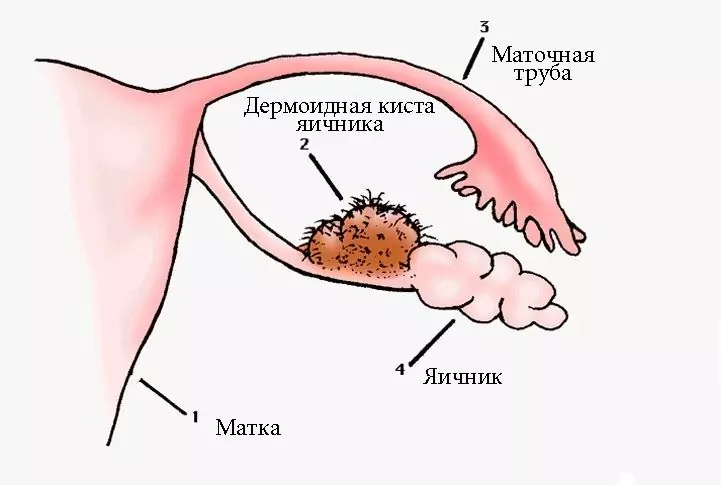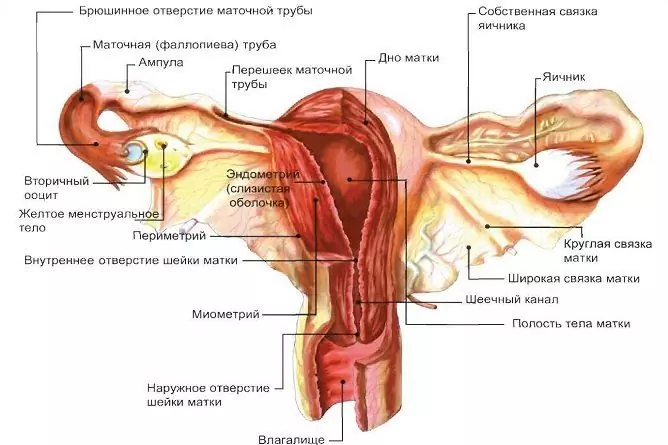- Author Rachel Wainwright [email protected].
- Public 2023-12-15 07:39.
- Last modified 2025-11-02 20:14.
Serous ovarian cyst
The content of the article:
- Serous ovarian cyst - what is it?
- The reasons
- Kinds
- Symptoms
- Complications
- Diagnostics
- Treatment
- Forecast and prevention
- Video
Serous ovarian cyst (cilioepithelial or simple cystadenoma, serous cystoma) is a true benign neoplasm originating from the ovarian epithelium.
The disease is most common in women between the ages of 30 and 50. The tumor usually reaches a size of 5-15 cm, but in some cases its diameter can be much larger (up to 35 cm).
In 28% of patients, cystadenoma is a multi-chamber formation, and in the rest it is a single-chamber formation.

Serous ovarian cysts occur in women of reproductive age
Serous ovarian cyst - what is it?
Serous cystoma usually forms in one ovary. It is a smooth-walled (single-chambered or multi-chambered) formation, the inner walls of which are lined with ciliated cylindrical or cubic single-layer epithelium. Epithelial cells secrete serous fluid (clear, light yellow). The gradual accumulation of this fluid leads to the expansion of the capsule of the tumor-like formation and its growth. At the same time, it begins to squeeze the nerve fibers, which becomes the cause of the pain syndrome.
When a cystadenoma is infected, its surface becomes dull, and the contents become cloudy. If the inflammatory process continues to spread, then over time, adhesions will begin to form.
The reasons
Currently, the exact causes of cystadenomas are unknown. It is assumed that long-term functional ovarian cysts (corpus luteum, follicular) lead to their occurrence. Over time, their cavity fills with serous fluid and increases in size.
The predisposing factors for the occurrence of a serous cyst are:
- hormonal disorders;
- severe somatic diseases;
- severe stress;
- pronounced physical overload;
- long-term adherence to extreme low-calorie diets;
- prolonged sexual abstinence;
- earlier (up to 12-14 years old) puberty;
- specific and nonspecific infectious and inflammatory diseases of the female genital organs;
- surgical interventions on the pelvic organs (uterus, ovaries, bladder, large intestine);
- hereditary predisposition.
Kinds
Depending on the structural features of the inner walls of the cystic formation, two types of cystadenomas are distinguished:
- Smooth-walled serous cyst. Almost never degenerates into a malignant tumor.
- Rough-papillary (papillary) serous cyst. On the inner walls there are dense whitish growths on a wide stalk. Malignancy, that is, malignancy is observed in 50% of cases.
Symptoms
With smooth-walled small serous cystomas, the diameter of which does not exceed 3-4 cm, there are no clinical symptoms. Usually, such tumors are discovered by chance during an ultrasound of the pelvic organs or a gynecological examination.
As the education grows, the patient shows signs of the disease:
| Sign | Explanation |
| Pain | Has a dull aching character (much less cramping). Pain sensations are localized behind the pubis or in the groin area, can be given to the lumbar region. |
| Dysfunction of the pelvic organs | The tumor presses on the walls of the rectum and bladder. This leads to the appearance of a foreign body sensation of these organs, dysuric disorders, constipation |
| Abdominal wall | With a significant size of cystadenoma, the abdomen increases, there is a visible asymmetry of the anterior abdominal wall |
| Menstrual function | Usually not broken. Some patients may develop algodismenorrhea. |
| General state | Does not suffer |
Complications
The most common complications of a serous ovarian cyst are:
- malignancy (with papillary form of the disease);
- torsion of the cyst leg;
- rupture of the capsule.
When the legs are twisted or the capsule ruptures, the patient develops a symptom complex of an acute abdomen, which is characterized by the following symptoms:
- severe abdominal pain;
- nausea, repeated vomiting;
- increased body temperature;
- severe weakness;
- pallor of the skin;
- delay in passing gas and stool.
Diagnostics
To make the correct diagnosis, all patients with suspected cystadenoma are prescribed an examination, which includes:
- bimanual gynecological examination;
- Ultrasound of the pelvic organs;
- computed or magnetic resonance imaging;
- a blood test for tumor markers (CA 72-4, CA 19-9, CA-125);
- color dopplerography.
Differential diagnosis is carried out with the following diseases:
- functional ovarian formations;
- tubovarian abscess;
- ectopic pregnancy;
- appendicitis;
- diverticulosis of the sigmoid colon;
- malformations of the genitourinary system;
- tumors of the pelvic organs.
Treatment
The main treatment for cystadenoma is its removal by surgery. There are no reliable data on the effectiveness of conservative therapy (medication, physiotherapy) and alternative methods.
The choice of the method of operation in each case is carried out by the attending physician, taking into account the size of the tumor, the presence or planning of pregnancy in the future, the woman's age, the presence or absence of concomitant diseases. Patients of reproductive age usually undergo cystectomy (exfoliation of the cyst walls with subsequent suturing of its bed) or ovarian resection with the maximum possible preservation of unchanged tissue. For women in the perimenopausal period, doctors usually recommend a radical operation, which consists in completely removing the affected ovary (oophorectomy). If a malignant degeneration of a cystic formation is suspected, bilateral removal of the ovaries and the body of the uterus is performed (hysterectomy with bilateral oophorectomy).
Attention! Photo of shocking content.
Click on the link to view.
The indications for elective surgery are:
- serous ovarian cystoma with a diameter of over 6 cm;
- preservation of education of any size over 4-6 menstrual cycles.
Emergency surgery is indicated for all patients with suspected torsion of the leg or rupture of the serous cystoma capsule.
Currently, planned operations are most often carried out by the laparoscopic method, and emergency operations - by laparotomy (with the traditional dissection of the anterior abdominal wall).
Timely surgical treatment of cystadenoma prevents the occurrence of ovarian cancer and ensures a high quality of life for patients.
Forecast and prevention
With timely diagnosis and treatment, the prognosis is generally favorable. After undergoing organ-preserving surgery, women of childbearing age are advised to protect themselves from pregnancy for at least 2-3 months.
Prevention of the formation of serous adenomas includes:
- early detection and treatment of inflammatory diseases of the female genital area;
- rejection of promiscuous sex life;
- observance of the regime of alternation of work and rest, avoidance of physical and psycho-emotional overload;
- proper balanced nutrition;
- leading an active lifestyle.
According to American gynecologists, in the prevention of benign serous cysts, the use of monophasic oral combined contraceptives by women of reproductive age is of no small importance.
Video
We offer for viewing a video on the topic of the article.

Elena Minkina Doctor anesthesiologist-resuscitator About the author
Education: graduated from the Tashkent State Medical Institute, specializing in general medicine in 1991. Repeatedly passed refresher courses.
Work experience: anesthesiologist-resuscitator of the city maternity complex, resuscitator of the hemodialysis department.
Found a mistake in the text? Select it and press Ctrl + Enter.






